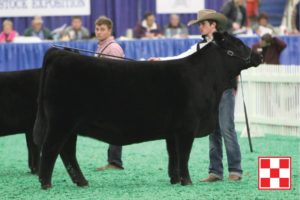 When you want to be successful at sports, you don’t just show up for games and expect to win. You attend team practices, you practice at home and you follow the game plan outlined by the coach. The same concept applies to showing cattle. You prepare for the ‘game’ through daily animal care, grooming and seeking guidance from the pros or a ‘coach.’ You follow that game plan right up until show day.
When you want to be successful at sports, you don’t just show up for games and expect to win. You attend team practices, you practice at home and you follow the game plan outlined by the coach. The same concept applies to showing cattle. You prepare for the ‘game’ through daily animal care, grooming and seeking guidance from the pros or a ‘coach.’ You follow that game plan right up until show day.
Bob May, Purina® Honor® Show Chow® Ambassador from Mineral Point, Wis., uses an intense and individualized game plan for each of his cattle.
“Success in the showring starts with the cattle’s conformation, but is achieved with consistent hard work and daily care to get the cattle where they need to be at the show,” says May.
The calf may be the star athlete, but even the best athletes don’t perform well without proper daily training, management and a supportive team behind them.
May suggests the following daily care tips to help take your show project to the next level:
1. Involve a veterinarian. Before an animal arrives at your farm, have a plan in place through your veterinarian for health and vaccination protocols. Ask the prior owner for a full health history on the animal, so you can have all of the animal’s health information at hand.
2. Earn the animal’s trust. A show calf needs to trust you, and trust comes in the form of working with the animal on a daily basis. It may be a long, slow process, but it’s one that’s essential to form a partnership with your project animal.
3. Have a consistent feeding routine. May suggests feeding individually at the same time each day. Cattle crave consistency, and when they are fed inconsistently they might also eat inconsistently. May also emphasizes that calves may eat better when they eat in a group setting. To make this possible, he will place individual calves in different runs nose-to-nose and feed them at the same time to mimic feeding in a group.
4. Monitor feed intake. Monitor what your animal is consuming at each feeding, and clean out old feed immediately. May has seen cases where new feed is simply dumped on top of old feed.
“You can quickly lose track of how much feed your calf is actually consuming,” explains May. “You think they are getting 15 pounds at night, and they are actually getting 18 because someone didn’t clean out the old feed from the morning.”
5. Ensure water availability and quality. Animals should have access to clean, cool water at all times. This basic animal care tip is sometimes overlooked, according to May.
“We clean our water tanks frequently,” May says. “Clean, cool water will keep cattle drinking and eating in those hot summer months when consumption usually drops off.”
6. Keep pens and cooler rooms clean. May mentions a good rule of thumb is if it smells or looks wet or dirty – clean it. A clean pen or cooler room will make grooming and daily care of the animal easier for both the animal and the exhibitor.
“If you don’t want to be in those pens or cooler rooms because of the smell, then the animal doesn’t want to be either,” he explains. “Cooler rooms do not equate to hair growth. Cleanliness is most important for hair growth.”
7. Learn the hair cycles. Hair grows in 90-day cycles, and this knowledge can help you determine what stage an animal’s hair will be in (or you want to be in) as you arrive at your show date. For example, for a show in August, May’s goal is to have all the old hair removed by the middle of May.
May doesn’t shear off any of his calves, but recognizes this is a standard practice for some breeds. Instead, he relies on a shedding comb to bust through and remove old hair. The shedding comb works best when hair is dirty and dusty, not wet or caked with manure.
8. Practice, practice, practice. May has his own children show their animals in competition at least twice before heading to their target show. This allows the animals and exhibitors to shake their ‘first-time jitters.’
“Specifically at the county fair level, it may be the first and only time both the kids and the cattle have seen the showring,” he explains. “And usually, that is not a good experience for the exhibitor or the animal.”
9. Find a hoof trimmer you can trust. May encourages all exhibitors to seek an expert in hoof care and recommends networking with other show enthusiasts to find a good trimmer in your area. Unlike clipping and fitting, there is little room for practice on hooves.
“Find a good hoof trimmer that will do a little trimming on the top, but does most of the work underneath the hoof,” he says. “A bad hoof trimming can result in disaster.”
10. Stick to the game plan. Have a management plan. Identify important dates before the show, and execute your plan daily.
“If you don’t focus on the management, other exhibitors will,” explains May. “And quite simply, if you don’t focus – those that do will beat you. They will be better prepared.”
Source: Purina Animal Nutrition
